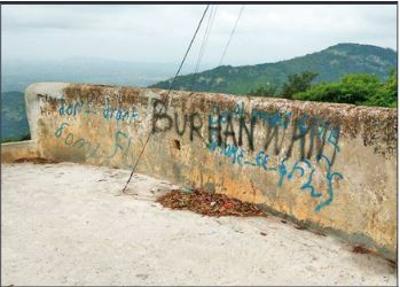BENGALURU: From graffiti artists painting the nation and in particular Bengaluru, with their innovative art, several social and political messages have been conveyed by graffiti artists.
At the other end of the spectrum, graffiti is also increasingly being used by artists to convey a viewpoint.
As politics and unrest rages on in Kashmir in the aftermath of the killing of Burhan Wani+ , commander of the Kashmir-based terror group Hizbul Mujahideen, graffiti about him has appeared in the premises of Tipu Sultan‘s summer palace fort in Nandi Hills, on the outskirts of Bengaluru.
Alongside Wani’s name in black spray paint is that of Olympian gymnast Dipa Karmakar+ , painted in red with a red star atop her name. While the common man may ignore the names of these figures as being the work of miscreants at a popular tourist destination, the names inspire mixed feelings for those who read them with perspective. From the choice of colours to the intent behind the graffiti, artists believe there is a deeper meaning for a chosen few and even for the artists who paint it.
TOI spoke to a couple of graffiti artists on whether the art form holds water and what it means to have such scribbles in public domain. Badal Nanjundaswamy ,a prominent exponent of the art form who conveys social messages with designs on potholes and leaking water supply lines, said all graffiti holds meaning for the artist and intellectuals who grasp its intent.
“All graffiti is an expression of the artist. We cannot categorically say whether the expression is right or wrong. There has been controversial graffiti of the Mona Lisa in Kerala. Artists tend to express the injustice in society with their art,” he said.
Agreeing with the scouting of locations by graffiti artists, exponent Shaunak Mahbubani said on a general level, each one of them is looking for a location where there can be a conversation.”However, locations like historically protected monuments to propagate political messages tend to detract people from the graffiti movement,” he said
The Archaeological Survey of India (ASI) said it has no control over the Nandi Hills fort, barring Tipu’s guest house, while the state archaeological department said it will get the graffiti immediately removed.
“People should respect and feel responsible for the culture and heritage we have inherited. We need to safely pass it on to our future generations and once destroyed, it can’t be recreated,” said commissioner for the state archaeology department Manjula.
(Times Of India)

